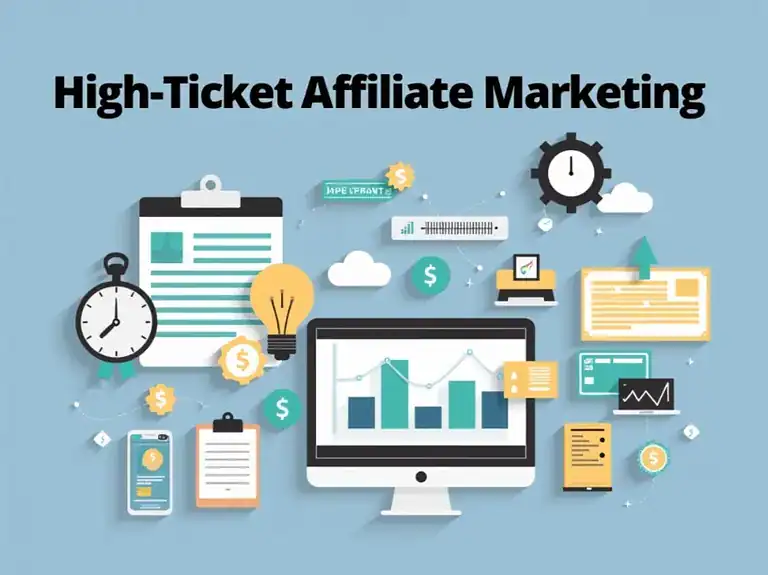How to Create a High-Converting Affiliate Landing Page
An affiliate landing page is a standalone webpage designed specifically to promote affiliate products effectively. It drives visitors toward a clear action—usually clicking your affiliate link or signing up for offers—to boost conversions and earn commissions.
High-performing affiliate landing pages contain compelling content, strategic calls-to-action (CTAs), optimized user experience, and smart SEO practices.
Key Takeaways:
-
Definition: An affiliate landing page promotes products and drives visitor action, like clicking links or signing up.
-
Key Features: Includes engaging content, clear CTAs, optimized UX, and effective SEO.
-
Purpose: Focused on conversion, addressing reader pain points with minimal distractions.
-
Essential Elements: Compelling headlines, concise text, visuals, social proof, mobile-friendliness, and SEO optimization.
-
Common Mistakes: Avoid distractions, poor mobile design, unclear CTAs, and missed leads.
-
Next Steps: Choose a builder, create content, optimize for SEO, and test for performance.
What Exactly Is an Affiliate Landing Page?
Imagine a simple webpage that speaks directly to your reader. It doesn’t shout, sell aggressively, or confuse. It just informs and gently guides visitors toward clicking affiliate links. That’s your affiliate landing page: straightforward, clear, and targeted.
Unlike regular blog posts, these pages focus tightly on conversion. They’re carefully optimized for keywords like “landing page optimization,” “affiliate marketing landing page,” and “high-converting landing page” to attract searchers primed to act.
Why You Need an Affiliate Landing Page
You might think, “Why bother? Can’t I just drop links into my posts?” You could—but don’t expect great results. A dedicated affiliate landing page boosts conversions dramatically by:
- Providing laser-focused content.
- Reducing distractions.
- Directly addressing reader pain points.
- Improving “conversion rate optimization.”
Affiliate marketers who use dedicated landing pages consistently outperform those who don’t.
Essential Elements of a High-Converting Affiliate Landing Page
Here’s a simple checklist for creating winning landing pages:
- Clear, engaging headlines (use your main keyword).
- Short but informative paragraphs for readability.
- Relevant images or videos.
- Social proof (user testimonials, reviews).
- Strategic CTAs were placed throughout.
- Mobile-friendly “landing page design” for optimal “user experience.”
- SEO optimization (meta descriptions, tags, URL slugs).
Step-by-Step Guide to Creating Your Affiliate Landing Page
Follow these steps carefully:
1. Choose the Right Landing Page Builder
Popular “landing page builders” include Elementor, Leadpages, and ClickFunnels. Pick one that suits your skill level and budget.
2. Design for User Experience and Conversion
Great “landing page templates” help, but always customize them. Keep the design clean and navigation simple. Include internal links to helpful resources like these:
3. Write Engaging and Optimized Content
Use related LSI keywords naturally (e.g., “landing page best practices,” “marketing funnel,” “page optimization“). Keep it simple, clear, and authentic. Pro tip: Check out How to Write Niche-Specific Content for practical advice.
4. Optimize for Search Engines and Featured Snippets
- Use proper header hierarchy (H1, H2, H3).
- Include bullet lists, numbered steps, and tables.
- Write schema-ready content to capture featured snippets.
5. Publish and Test Your Page
Measure performance regularly (conversion rates, bounce rates). Adjust elements based on results.
Affiliate Landing Page Examples and Comparisons
Check out the comparison table below to understand what works:
Best Practices for Your Affiliate Landing Page Strategy
- Provide value before asking visitors to click.
- Keep testing headlines, CTAs, and page layouts.
- Leverage “digital marketing” and “online marketing” techniques for traffic.
Read more about optimizing your affiliate strategy in How to Increase Your Affiliate Marketing Conversion Rate.
Common Mistakes to Avoid
- Too many distractions or outbound links.
- Poor mobile optimization.
- Lack of clear CTAs.
- Ignoring “lead capture” opportunities.
Avoid these pitfalls by checking out Affiliate Marketing Mistakes.
Leveraging AI for Affiliate Landing Pages
Artificial intelligence tools (like ChatGPT and its best alternatives) can help generate compelling copy and optimize your page quickly. To learn more, explore The Power of AI in SEO.
FAQs
What’s the difference between a “squeeze page” and an affiliate landing page?
A squeeze page captures emails specifically, while an affiliate landing page encourages visitors to click affiliate links.
How do I measure success?
Track metrics like clicks, conversions, and bounce rate. Use analytics tools for insights.
Final Thoughts: Crafting Your Effective Affiliate Landing Page
Creating a powerful affiliate landing page isn’t rocket science—just clarity, simplicity, and focus. Continuously test, adjust, and refine your page to optimize performance. Ready to dive deeper?
Check out these helpful resources:
Your Next Steps:
- Choose your “landing page builder.“.
- Write clear, compelling content.
- Optimize your page using “landing page optimization” techniques.
- Test, measure, refine—repeat.
Now, go build your high-converting affiliate landing page and watch those commissions roll in.
References:
- https://landingi.com/blog/affiliate-marketing-landing-pages/
- https://www.hostnoc.com/high-converting-affiliate-landing-pages/
- https://www.getresponse.com/blog/affiliate-landing-pages
- https://www.sender.net/blog/high-converting-landing-pages/
- https://affiliatewp.com/addons/affiliate-landing-pages/
- https://landerlab.io/blog/affiliate-landing-page
- https://richads.com/blog/10-high-converting-landing-page-examples-for-affiliate-marketing-best-practices/
- https://impact.com/affiliate/a-winning-affiliate-marketing-landing-page-3-proven-strategies-plus-inspiring-examples/
- https://saaslandingpage.com/articles/20-affiliate-marketing-landing-page-examples/
- https://www.vivianagency.com/referral-landing-page-examples-how-to-attract-affiliates/
- https://www.reddit.com/r/Affiliatemarketing/comments/134gr4u/how_and_where_do_you_create_a_landing_page_and/
- https://partnerize.com/resources/blog/4-excellent-examples-of-affiliate-marketing-program-landing-pages
- https://www.youtube.com/watch?v=hHM1IFdsqIA
- https://trackdesk.com/blog/create-affiliate-landing-page
- https://moosend.com/blog/landing-page-builders-for-affiliate-marketing/
- https://tapfiliate.com/blog/ecommerce-landing-pages/
- https://affiliatewp.com/affiliate-program-landing-page/
- https://www.mobidea.com/academy/affiliate-landing-pages/
- https://landingi.com/landing-page/affiliate-best-practices/
- https://www.searchenginejournal.com/ux-landing-page-inspiration-unbounce-spa/541224/
- https://narrato.io/blog/affiliate-marketing-landing-page-examples-and-tips-to-inspire-your-campaign/
- https://www.optimizepress.com/high-converting-landing-page-examples/
- https://blog.hubspot.com/marketing/fantastic-landing-page-examples
I’m Alexios Papaioannou, an experienced affiliate marketer and content creator. With a decade of expertise, I excel in crafting engaging blog posts to boost your brand. My love for running fuels my creativity. Let’s create exceptional content together!
You Might Also Like
- For more insights on this topic, you might find our exploration of Affiliate Marketing for Beginners: 2025 Guide to $1K/Month valuable Affiliate Marketing for Beginners: 2025 Guide to $1K/Month.
- To see how this works in practice, our Affiliate Content: 7 Surprising Strategies [Year] Revealed examples demonstrate real-world applications Affiliate Content: 7 Surprising Strategies [Year] Revealed.
- To understand this better, consider reading about Optimize Affiliate Website SEO: 7 Proven Steps [Year] Optimize Affiliate Website SEO: 7 Proven Steps [Year].








